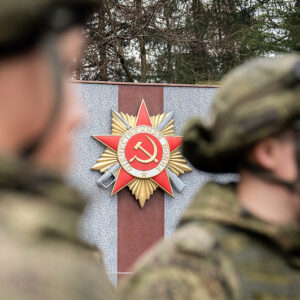The following is the latest weekly update on the Russian invasion of Ukraine, written by John Hardie, deputy director of the Russia Program at the Foundation for Defense of Democracies.
Russians Take Eastern Bakhmut, While Zelenskyy Vows to Hold the Rest
Russia’s Wagner paramilitary group has captured the eastern part of Bakhmut, Kremlin-connected businessman Yevgeny Prigozhin, who heads the organization, claimed on Wednesday. Ukrainian forces had recently withdrawn across the Bakhmutovka River, which splits the city. A Telegram channel associated with Wagner said the group is now pushing toward a metals plant in northern Bakhmut and toward the Sobachivka district in the city’s south.
Days earlier, a Russian missile strike reportedly destroyed a road bridge in Khromove, just west of Bakhmut, blocking — at least temporarily — Ukraine’s best remaining route into the city. This may exacerbate supply shortages that have hamstrung Ukraine’s defense of Bakhmut. Over the past couple weeks, Ukraine has launched counterattacks attempting to halt Russian advances and push Moscow’s forces back from that road and a nearby highway into Bakhmut.
Although Russian forces have nearly encircled Bakhmut from the north and south, Kyiv insists it will continue to fight for the city. On Wednesday, Colonel-General Oleksandr Syrsky, commander of Ukrainian forces in the country’s east, personally visited Bakhmut for the fourth time in two weeks. His visit came after Ukrainian President Volodomyr Zelenskyy on Monday said he had ordered his military to send reinforcements to hold Bakhmut. A press release from Zelenskyy’s office claimedSyrsky and General Valerii Zaluzhnyi, Ukraine’s top general, had “spoke in favor” of reinforcing Bakhmut during a Monday meeting of Ukraine’s high command.
Hours earlier, Germany’s Bild had reported that Zaluzhnyi had advocated a retreat from Bakhmut weeks earlier to preserve Ukrainian forces. Kyiv insists that continuing to fight for Bakhmut will grind down Russian forces, but the Ukrainian military is also taking heavy losses there. By clinging to Bakhmut at this stage, Ukraine risks undermining its ability to retake more militarily significant territory in its much-anticipated counteroffensive later this year.
Western Export Controls Targeting Russia’s Defense Industrial Base Are Falling Short
A senior European diplomat admitted that Moscow appears to be successfully circumventing Western export controls designed to block it from importing microelectronics and other sensitive goods needed by Russia’s defense industry, Bloomberg reported on March 4. This admission aligns with independent studies that indicate Russian imports of microelectronics actually grew in 2022 despite Western restrictions.
Russia’s defense industrial base remains reliant on Western technology, particularly microelectronics. Analyses of Russian missiles and other weapons used in Ukraine reveal that many are replete with Western chips. Washington and its Western allies have sought to exploit this dependence. When Moscow invaded Ukraine in February 2022, they expanded restrictions on the exportation of microelectronics and other sensitive items to Russia. Notably, the U.S. Commerce Department barred foreign companies from sending Russia such products if they were made using U.S.-origin equipment, software, or technology. Nearly all microchips made worldwide involve at least some U.S. inputs.
However, Moscow has extensive experience, dating back to the Soviet era, in circumventing Western export controls. Indeed, many Western components discovered in Russian weapons used in Ukraine were covered by export controls when Russia acquired them. Russia’s intelligence services have likely doubled their efforts on this front since last year’s invasion.
As the European diplomat noted, Russia has managed to acquire advanced Western-made microelectronics by routing its imports through third countries. The Russians often dodge Western restrictions by hiding behind offshore shell companies or going through foreign traders. China appears to be the worst culprit. According to a recent study, China accounted for over a third of Russian imports of semiconductors and electronic integrated circuits in January-September 2022, worth over $900 million — up from $400 million in 2021. Another investigation identified a Hong Kong shell company that “shipped at least $210 million in electronics to Russia since April 1, including at least $50 million” from U.S. firms.
All this means that while many in the West would like to think that export controls have crippled Russia’s defense production, that doesn’t appear to be true. In fact, FDD’s Long War Journal has found that Russian production of Kh-101 cruise missiles not only continues but may have actually increased since Moscow invaded Ukraine last year.
The Biden administration and Western allies have signaled improving enforcement of export controls and other restrictions against Russia will be a priority this year. So far, however, the Treasury Department has only nibbled around the edges when it comes to penalizing Chinese entities that violate U.S. sanctions by supporting Russia’s defense industry.




